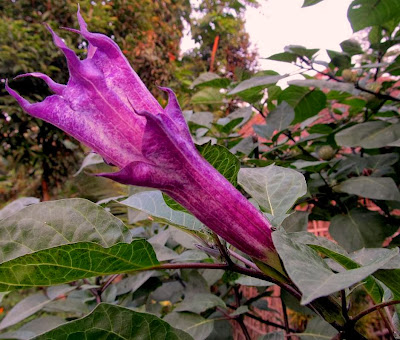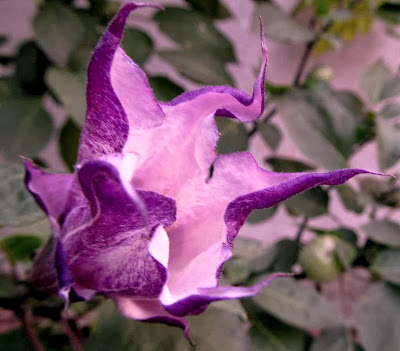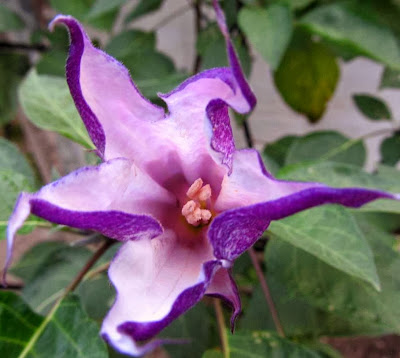Scientific classification
Kingdom : Plantae
(unranked): Angiosperms
(unranked): Eudicots
(unranked): Asterids
Order: Solanales
Family: Solanaceae
Genus: Datura
Species: D.metel
Binomial name: Datura metel
Datura metel is a shrub-like perennial herb, commonly known as devil's trumpet and metel.Datura metel grows in the wild in all the warmer parts of the world, and is cultivated worldwide for its chemical and ornamental properties. It was first described by Linnaeus in 1753, but no botanically correct illustrations or descriptions were made until after the New World was settled. It is not possible to be sure about its original home.
The plant is an annual herb growing up to 3 ft. high. It is slightly furry, with dark violet shoots and oval to broad oval leaves that are often dark violet as well. The pleasantly-scented 6-8 in. flowers are immensely varied, and can be single or double. Colors range from white to cream, yellow, red, and violet. The seed capsule is covered with numerous conical humps and a few spines It is similar to D. inoxia, but D. metel has almost glabrous leaves and fruits that are knobby, not spiny. D. inoxia is pilose all over and has a spiny fruit.
D. metel is one of the 50 fundamental herbs used in traditional Chinese medicine, where it is called yáng jīn huā. However, the ingestion of D. metel in any form is dangerous and should be treated with extreme caution.
All parts of Datura plants contain dangerous levels of tropane alkaloids (highly poisonous) and may be fatal if ingested by humans or other animals, including livestock and pets. In some places, it is prohibited to buy, sell or cultivate Datura plants.
Datura metel may be toxic if ingested in a tiny quantity, symptomatically expressed as flushed skin, headaches, hallucinations, and possibly convulsions or even a coma. The principal toxic elements are tropane alkaloids. Accidentally (or intentionally) ingesting even a single leaf could lead to severe side effects.
Black daturas (Datura metel 'Fastuosa')
A cultivar of D. metel with a polished-looking ebony-black stem exists as a garden plant. Its flowers normally have a double or triple corolla, each corolla having a deep purple exterior and white or off-white interior. The plant is already reported to have become naturalised in Israel (see illustration). The black cultivar might become a common roadside dweller, like its white-flowered ancestor.
It is known under several cultivar names such as 'Black', 'Blackcurrant Swirl', 'Cornucopaea', 'Double Blackcurrant Swirl', 'Double Purple', and 'Purple Hindu'. It has also received many scientific names which should not be used for a cultivar:
From ancient time people think God Shiva like Black Datura flower too much.
Camera used in photography-Canon Power Shot SX150 IS



No comments:
Post a Comment